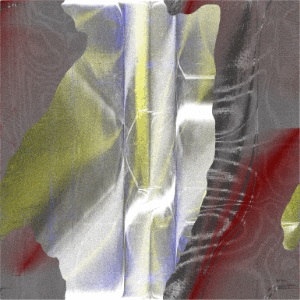Tim Martin had reached new heights of hyperactivity at our last igloo-view of Maps and Diagrams; there we found him ‘between mood paradigms of light and dark, playing off a reined in prettiness against a more ambiguous undertow, that guards against falling into the sea of twee, or straying into the land of bland inhabited by some of his sub-genre kin.’ Talk of wanting ‘to push the semblance of the album into the places between consciousness and smudged reality,’ (interview) attended Get Lost, a 2011 Time Released Sound whose 2013 recovery via Handstitched, along with year’s end delivery of its thematic sequel In Circles, plus others incl. digital updates of some sold out in physical formats, are occasion for a rear-view of Tim-released sound.
With five M & D releases—and others under the Atlantis alias, Martin’s clearly not been slacking. Last in before year’s end was In Circles, a thematic sequel to Get Lost. There maps were the territory, while here it’s diagrams—hand-stamped, hole-punched, in ink-penned translucent (75-yr old hand-inscribed) envelope. Sharing its precursor’s Wanderlust, a feeling of drift compounded by found sounds—“Valargo”’s crunch of footsteps, the train-bound rustle of papers of “Ten Black Cards,” delay-doused and static-steeped, in eponymous motion. The plucked strings of “A Bump in the Night” and the droning granular synthetic sprawl of “1895 (Moth Evolution)” extend unmoored, making for easy zoom-in and zone-out—out to the soothing ebb-flow of “Locus (AB),” in to the more attention-seeking polyphony of “Madrid (Orion).” Unlike some more abstract Diagrams (cf. Første below), In Circles hosts a prevailing melodic tenor and more defined forms, as on “Batika (Rust),” whose plosive plonks work like a hook over the usual ambient pad suspects. “Talavera,” cool and quiet, gathers three or four layers of drone to play shimmering over each other. “Bosque” unfolds in texture maps, harmonics and dense sweeps, ceding to a melancholy key. “Yesterday” initially strips the sound right back to a crackly wash with a birdcall figure then synth sweeps presage vocals—a surprise visit, gratifyingly short and sweet, and sympathetic in languid delivery with vague references to ‘the path and the oaks, the fjords and the lakes.’
Music of the higher spheres comes on the Laska EP, now also available digitally via Handstitched, having swiftly sold out on disc. A pellucid drone zone between the alte-Schule Kosmische of Cluster and nu-skool updates like OPN and Pale Blue Sky opens up with “Bicolour,” a nuanced piece of particulate oneirism, followed by the title piece’s intricate arrangement of delicate tintinnabulations. “Limosa” is replete with treated instruments suggestive of far-off provenance, closure coming with the shivery timbres of “Penelope” drawing out the last drops of the eternal from the ephemeral.
Timbre, which sold out as a Dronarivm ltd ed. cassette, is also now digitally accessible. It proposes a focus on tone colour and voice, a psycho-acoustic experience achieved through obscuring certain frequencies, while enhancing others. In common with all of M & D, there’s a clear impetus of motion in these short resonant sketches that transport the listener on a sonic trajectory between dissonance and consonance.
Being Empty is trailed in (doubtless knowingly) hyperbolic terms by Unknown Tone (label run by Tim’s mate, Mark, aka The New Honey Shade) as ‘an excursion into your very being,’ adding, somewhat preachily ‘music such as this is a tool aimed to provide peace for the soul, rather than becoming a narrow, material replacement aimed at blocking out the world and her troubles,’ before appealing to something immanent, ‘pointing the way past her inevitable sonic decay and her limitations to what can never rust or fade away.’ (blurb). For this listener these pieces are less occasion for cod-spiritual proselytizing, more a case of semiotic envelopes affording structures for questing code-crackers to access inner/outer worlds via careful auricular decoding (Deep Listening, if you prefer, without the new age waffle).
On Første, also a Hibernate postcard, M & D turns a few shades darker and gruzzier. Suggestively naturalistic, though a tad more abstract, it engages from the outset in “Meyeri,” with its wind-blown sea-sprayed sonorities and emergent neo-dub suffusions. “Heldelberg” takes us to world’s edge, where, again, a gathering storm is suggested through organic sequences, delicate synth motifs and undercurrents in dark water. “Gassefjord” references the old synth school, as if from another dimension. A certain understatement is evident throughout, blending natural and synthetic to the point where distinction dissolves. “Puynax” and “Goldfuss” suggest the same fjords and auroras and night sky as on our start-point In Circles, to one of which we now come. Full.
All above Maps and Diagrams releases are available on Handstitched or Unknown Tone.
http://youtu.be/ICTYc-rSbko



















![Hasbeen :: Bunker Symphonies II (Clean Error) — [concise]](https://igloomag.com/wp/wp-content/uploads/2025/04/hasbeen-bunker-symphonies-ii_feat-75x75.jpg)
![Extrawelt :: AE-13 (Adepta Editions) — [concise]](https://igloomag.com/wp/wp-content/uploads/2025/04/extrawelt-ae-13_v_feat-75x75.jpg)
![Beyond the Black Hole :: Protonic Flux EP (Nebleena) — [concise]](https://igloomag.com/wp/wp-content/uploads/2025/04/beyond-the-black-hole-protonic-flux_feat-75x75.jpg)
![H. Ruine, Mikhail Kireev :: Imagined / Awakenings (Mestnost) — [concise]](https://igloomag.com/wp/wp-content/uploads/2025/04/h-ruine-mikhail-kireev-imagined-awakenings_feat2-75x75.jpg)


![Squaric :: 808 [Remixes] (Diffuse Reality) — [concise]](https://igloomag.com/wp/wp-content/uploads/2025/04/squaric-808-remixes_feat-75x75.jpg)

